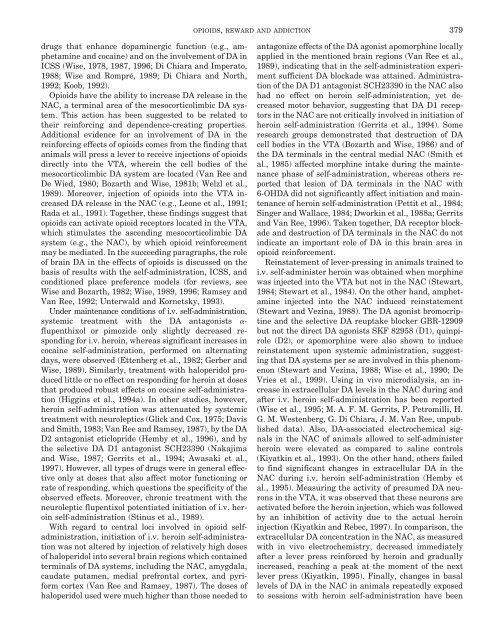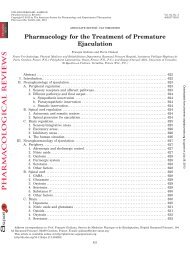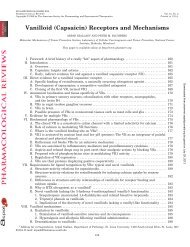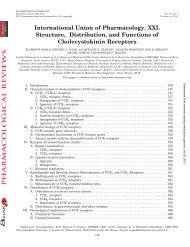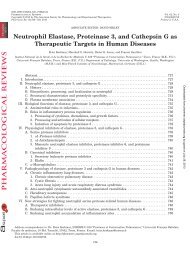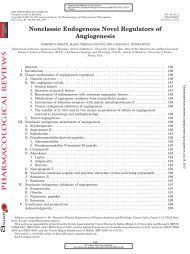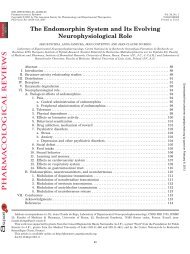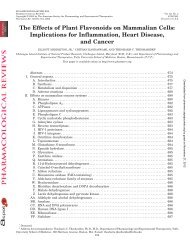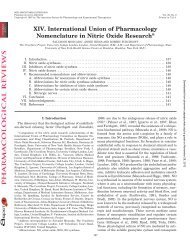Opioids, Reward and Addiction: An Encounter of Biology ...
Opioids, Reward and Addiction: An Encounter of Biology ...
Opioids, Reward and Addiction: An Encounter of Biology ...
Create successful ePaper yourself
Turn your PDF publications into a flip-book with our unique Google optimized e-Paper software.
drugs that enhance dopaminergic function (e.g., amphetamine<br />
<strong>and</strong> cocaine) <strong>and</strong> on the involvement <strong>of</strong> DA in<br />
ICSS (Wise, 1978, 1987, 1996; Di Chiara <strong>and</strong> Imperato,<br />
1988; Wise <strong>and</strong> Rompré, 1989; Di Chiara <strong>and</strong> North,<br />
1992; Koob, 1992).<br />
<strong>Opioids</strong> have the ability to increase DA release in the<br />
NAC, a terminal area <strong>of</strong> the mesocorticolimbic DA system.<br />
This action has been suggested to be related to<br />
their reinforcing <strong>and</strong> dependence-creating properties.<br />
Additional evidence for an involvement <strong>of</strong> DA in the<br />
reinforcing effects <strong>of</strong> opioids comes from the finding that<br />
animals will press a lever to receive injections <strong>of</strong> opioids<br />
directly into the VTA, wherein the cell bodies <strong>of</strong> the<br />
mesocorticolimbic DA system are located (Van Ree <strong>and</strong><br />
De Wied, 1980; Bozarth <strong>and</strong> Wise, 1981b; Welzl et al.,<br />
1989). Moreover, injection <strong>of</strong> opioids into the VTA increased<br />
DA release in the NAC (e.g., Leone et al., 1991;<br />
Rada et al., 1991). Together, these findings suggest that<br />
opioids can activate opioid receptors located in the VTA,<br />
which stimulates the ascending mesocorticolimbic DA<br />
system (e.g., the NAC), by which opioid reinforcement<br />
may be mediated. In the succeeding paragraphs, the role<br />
<strong>of</strong> brain DA in the effects <strong>of</strong> opioids is discussed on the<br />
basis <strong>of</strong> results with the self-administration, ICSS, <strong>and</strong><br />
conditioned place preference models (for reviews, see<br />
Wise <strong>and</strong> Bozarth, 1982; Wise, 1989, 1996; Ramsey <strong>and</strong><br />
Van Ree, 1992; Unterwald <strong>and</strong> Kornetsky, 1993).<br />
Under maintenance conditions <strong>of</strong> i.v. self-administration,<br />
systemic treatment with the DA antagonists flupenthixol<br />
or pimozide only slightly decreased responding<br />
for i.v. heroin, whereas significant increases in<br />
cocaine self-administration, performed on alternating<br />
days, were observed (Ettenberg et al., 1982; Gerber <strong>and</strong><br />
Wise, 1989). Similarly, treatment with haloperidol produced<br />
little or no effect on responding for heroin at doses<br />
that produced robust effects on cocaine self-administration<br />
(Higgins et al., 1994a). In other studies, however,<br />
heroin self-administration was attenuated by systemic<br />
treatment with neuroleptics (Glick <strong>and</strong> Cox, 1975; Davis<br />
<strong>and</strong> Smith, 1983; Van Ree <strong>and</strong> Ramsey, 1987), by the DA<br />
D2 antagonist eticlopride (Hemby et al., 1996), <strong>and</strong> by<br />
the selective DA D1 antagonist SCH23390 (Nakajima<br />
<strong>and</strong> Wise, 1987; Gerrits et al., 1994; Awasaki et al.,<br />
1997). However, all types <strong>of</strong> drugs were in general effective<br />
only at doses that also affect motor functioning or<br />
rate <strong>of</strong> responding, which questions the specificity <strong>of</strong> the<br />
observed effects. Moreover, chronic treatment with the<br />
neuroleptic flupentixol potentiated initiation <strong>of</strong> i.v. heroin<br />
self-administration (Stinus et al., 1989).<br />
With regard to central loci involved in opioid selfadministration,<br />
initiation <strong>of</strong> i.v. heroin self-administration<br />
was not altered by injection <strong>of</strong> relatively high doses<br />
<strong>of</strong> haloperidol into several brain regions which contained<br />
terminals <strong>of</strong> DA systems, including the NAC, amygdala,<br />
caudate putamen, medial prefrontal cortex, <strong>and</strong> pyriform<br />
cortex (Van Ree <strong>and</strong> Ramsey, 1987). The doses <strong>of</strong><br />
haloperidol used were much higher than those needed to<br />
OPIOIDS, REWARD AND ADDICTION 379<br />
antagonize effects <strong>of</strong> the DA agonist apomorphine locally<br />
applied in the mentioned brain regions (Van Ree et al.,<br />
1989), indicating that in the self-administration experiment<br />
sufficient DA blockade was attained. Administration<br />
<strong>of</strong> the DA D1 antagonist SCH23390 in the NAC also<br />
had no effect on heroin self-administration, yet decreased<br />
motor behavior, suggesting that DA D1 receptors<br />
in the NAC are not critically involved in initiation <strong>of</strong><br />
heroin self-administration (Gerrits et al., 1994). Some<br />
research groups demonstrated that destruction <strong>of</strong> DA<br />
cell bodies in the VTA (Bozarth <strong>and</strong> Wise, 1986) <strong>and</strong> <strong>of</strong><br />
the DA terminals in the central medial NAC (Smith et<br />
al., 1985) affected morphine intake during the maintenance<br />
phase <strong>of</strong> self-administration, whereas others reported<br />
that lesion <strong>of</strong> DA terminals in the NAC with<br />
6-OHDA did not significantly affect initiation <strong>and</strong> maintenance<br />
<strong>of</strong> heroin self-administration (Pettit et al., 1984;<br />
Singer <strong>and</strong> Wallace, 1984; Dworkin et al., 1988a; Gerrits<br />
<strong>and</strong> Van Ree, 1996). Taken together, DA receptor blockade<br />
<strong>and</strong> destruction <strong>of</strong> DA terminals in the NAC do not<br />
indicate an important role <strong>of</strong> DA in this brain area in<br />
opioid reinforcement.<br />
Reinstatement <strong>of</strong> lever-pressing in animals trained to<br />
i.v. self-administer heroin was obtained when morphine<br />
was injected into the VTA but not in the NAC (Stewart,<br />
1984; Stewart et al., 1984). On the other h<strong>and</strong>, amphetamine<br />
injected into the NAC induced reinstatement<br />
(Stewart <strong>and</strong> Vezina, 1988). The DA agonist bromocriptine<br />
<strong>and</strong> the selective DA reuptake blocker GBR-12909<br />
but not the direct DA agonists SKF 82958 (D1), quinpirole<br />
(D2), or apomorphine were also shown to induce<br />
reinstatement upon systemic administration, suggesting<br />
that DA systems per se are involved in this phenomenon<br />
(Stewart <strong>and</strong> Vezina, 1988; Wise et al., 1990; De<br />
Vries et al., 1999). Using in vivo microdialysis, an increase<br />
in extracellular DA levels in the NAC during <strong>and</strong><br />
after i.v. heroin self-administration has been reported<br />
(Wise et al., 1995; M. A. F. M. Gerrits, P. Petromilli, H.<br />
G. M. Westenberg, G. Di Chiara, J. M. Van Ree, unpublished<br />
data). Also, DA-associated electrochemical signals<br />
in the NAC <strong>of</strong> animals allowed to self-administer<br />
heroin were elevated as compared to saline controls<br />
(Kiyatkin et al., 1993). On the other h<strong>and</strong>, others failed<br />
to find significant changes in extracellular DA in the<br />
NAC during i.v. heroin self-administration (Hemby et<br />
al., 1995). Measuring the activity <strong>of</strong> presumed DA neurons<br />
in the VTA, it was observed that these neurons are<br />
activated before the heroin injection, which was followed<br />
by an inhibition <strong>of</strong> activity due to the actual heroin<br />
injection (Kiyatkin <strong>and</strong> Rebec, 1997). In comparison, the<br />
extracellular DA concentration in the NAC, as measured<br />
with in vivo electrochemistry, decreased immediately<br />
after a lever press reinforced by heroin <strong>and</strong> gradually<br />
increased, reaching a peak at the moment <strong>of</strong> the next<br />
lever press (Kiyatkin, 1995). Finally, changes in basal<br />
levels <strong>of</strong> DA in the NAC in animals repeatedly exposed<br />
to sessions with heroin self-administration have been


